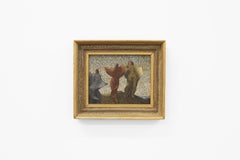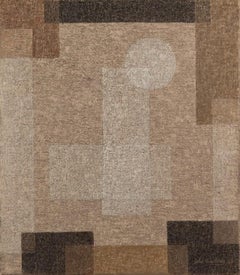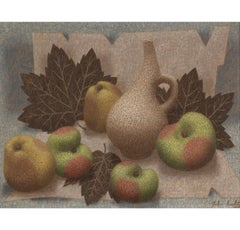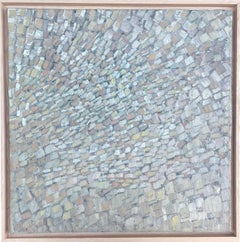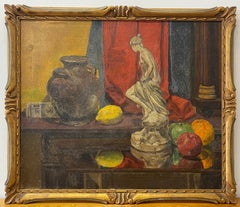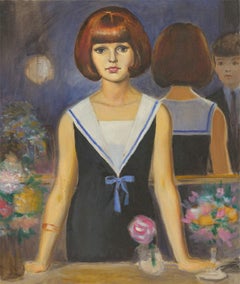John Armstrong Paintings
to
3
Overall Width
to
Overall Height
to
3
1
2
1
1
1
1
1
2
1
1
1
1
3
781
715
704
691
1
3
Artist: John Armstrong
Group of Figures
By John Armstrong
Located in London, GB
Signed with initials
Tempera on hand-made paper laid on panel
6 3/4 x 8 3/4 inches
Category
1940s John Armstrong Paintings
Materials
Tempera, Panel
Brown Abstract, Oil on Canvas Painting by John Armstrong, 1965
By John Armstrong
Located in Kingsclere, GB
Brown Abstract (6), Oil on Canvas Painting by John Armstrong 1893-1973, 1965
Literature/Press
Andrew Lambirth, 'John Armstrong: The Complete Paintings, Catalogue Raisonne', London: ...
Category
20th Century John Armstrong Paintings
Materials
Canvas, Oil
Still Life, Oil on Board Painting by John Armstrong, 1960
By John Armstrong
Located in Kingsclere, GB
Still Life, Oil on Board Painting by John Armstrong, 1960
Additional information:
Medium: Oil on board
11 1/4 x 15 1/8 in
28.5 x 38.5 cm
Signed and dated
This painting shows Armstrong's earlier career as a theatre designer, with its subjects arranged on a window sill as if actors in a play; the leaf and muntin, painted in a similar tone of green, act as a mid-ground to the autumnal trees outside the Artist's London home. Painted after Armstrong had returned to the city from Lamorna, Cornwall, as a struggling artist, models were too expensive and so he resorted to using fruits and vegetables from his local market. Showing a Cycladic vessel that appears in other works from 1957 onwards, as illustrated in Lambirth's book, including Still life with Mushrooms from 1961. The distinctive brick-like pattern of Armstrong's brushstrokes shines through here.
John Armstrong was a painter of imaginative subjects, designer of film and stage sets, mural painter and book illustrator.
Born in Hastings, Sussex, John Rutherford Armstrong attended St Paul's School, London, and studied law at St John's College, Oxford, before taking up art at St John's Wood School of Art (1913-14). He served in the Royal Field Artillery (1914-19) before returning to St John's Wood School for a short period after the war. His first one-man exhibition was at the Leicester Galleries in 1928, where he first met members of the Unit One group, joining them for their 1933 exhibition. It was after this that Armstrong's work began to develop a Surrealist character.
Much of Armstrong's oeuvre has its foundation in classical legend, landscape, or imagery, surely understandable given his classical education and WW1 service in the Near East. Varied Greek vase forms regularly make an appearance in his work from the mid-1930s, notably in his GPO poster...
Category
20th Century John Armstrong Paintings
Materials
Board
Related Items
Abstract Composition – Original Oil on Canvas – 31.5 x 31.5 in
Located in Montfort l’Amaury, FR
"A masterful expression of French lyrical abstraction, in a timeless, elegant palette."
Pierre Coquet (1926–2021)
Abstract Composition
Oil on canvas, 80 x 80 x 2 cm (31.5 x 31.5 x 0...
Category
1960s French School John Armstrong Paintings
Materials
Oil, Canvas
$5,288
H 31.5 in W 31.5 in D 0.79 in
Early 20th Century Still Life Oil Painting by C. G. Loane
Located in San Francisco, CA
Early 20th Century Still Life Oil Painting
Beautiful still life painting by Irish artist Cecilia G. Loane
Original oil on board
Dimensions 24" wide x 20.5" high
The frame measure...
Category
Early 20th Century John Armstrong Paintings
Materials
Oil, Board
Signed Midcentury Cubist Still Life Interior Table Scene with Fruit Oil Painting
Located in Buffalo, NY
A striking oil on canvas still life rendered in a late Cubist idiom, this 1968 composition by V. Melo presents a disciplined yet expressive tabletop scene. The spatial relationships ...
Category
1960s Cubist John Armstrong Paintings
Materials
Oil, Board
$1,180 Sale Price
20% Off
H 19 in W 23 in D 2 in
Antique American Cubist Abstract Flower Still Life Large Original Oil Painting
Located in Buffalo, NY
Vintage American modernist abstract still life oil painting. Oil on canvas. Framed. In excellent original condition. Handsomely framed in a wood molding. Excellent condition, re...
Category
1960s Cubist John Armstrong Paintings
Materials
Oil, Board
$1,980 Sale Price
20% Off
H 49 in W 37 in D 2 in
A Pointillist View of a Woman
Located in San Francisco, CA
The artist had a lot to say. Why else spend the intense focus and time on rendering such a luminous work brought to completion literally point by point in tiny dots? Ask yourself: Ar...
Category
Late 20th Century Pointillist John Armstrong Paintings
Materials
Canvas, Oil
Vintage American Impressionist Backyard Flower Wall Landscape Oil Painting
Located in Buffalo, NY
Vintage flower landscape oil painting. Oil on canvas. Framed. Signed. In excellent original condition. Handsomely framed in a wood molding. Excellent condition, ready to hang an...
Category
1960s Impressionist John Armstrong Paintings
Materials
Oil, Board
$300 Sale Price
20% Off
H 27 in W 21 in D 2 in
Antique American Oil Painting Still Life of Hanging Fruit and Grapes
Located in Buffalo, NY
Antique American still life oil painting of hanging fruit and grapes. Oil on board. Framed
Category
Late 19th Century American Realist John Armstrong Paintings
Materials
Oil, Board
$551 Sale Price
20% Off
H 21 in W 17 in D 1 in
“Sunflowers in Glass Vase” Signed Still Life Oil Painting by J. M. Dilekis
Located in Buffalo, NY
A richly painted still life of sunflowers by J. M. Dilekis, signed and dated 1994 in the lower right. Executed in oil on canvas, this classic composition features a lush bouquet of g...
Category
1990s Realist John Armstrong Paintings
Materials
Oil, Board
$780 Sale Price
20% Off
H 18 in W 16 in D 2 in
Vintage American Modernist Framed Abstract Expressionist White Flower Still Life
Located in Buffalo, NY
Vintage abstract flower still life oil painting. Oil on paper. Framed. In excellent original condition. Handsomely framed in a wood molding. Excellent condition, ready to hang an...
Category
1970s Abstract John Armstrong Paintings
Materials
Oil, Board
$380 Sale Price
20% Off
H 30 in W 26 in D 2 in
A Mexican Hillside Village Scene
Located in San Francisco, CA
The understated palette is the surprise here, given that it’s Mexico. No blinding white plaster walls. No bright green palms, hot pink bougainvillea and turquoise sea on the horizon,...
Category
20th Century Abstract John Armstrong Paintings
Materials
Canvas, Oil
Vintage French Surrealist Still Life Eiffel Tower Realist Paris Modern Painting
Located in Buffalo, NY
Vintage French modernist still life oil painting. Framed. Oil on canvas.
Category
1940s Impressionist John Armstrong Paintings
Materials
Oil, Board
$1,275
H 20 in W 23 in D 2 in
Antique American Abstract Expressionist Framed Original Oil Painting
Located in Buffalo, NY
Antique American abstract oil painting. Oil on board. Framed. In excellent original condition. Handsomely framed in a giltwood molding. Excellent condition, ready to hang and en...
Category
1950s Abstract Expressionist John Armstrong Paintings
Materials
Oil, Board
$700 Sale Price
20% Off
H 24 in W 20 in D 2 in
Previously Available Items
John Armstrong - 20th Century Oil, Portrait of a Woman
By John Armstrong
Located in Corsham, GB
An impressive portrait by listed comic book artist John Armstrong showing a young woman wearing her hair in a fashionable 1960s style. The graphic influences are evident in this artwork. Armstrong has emphasised the features of the sitter, giving the woman large emotive eyes, a classic comic illustration...
Category
21st Century and Contemporary John Armstrong Paintings
Materials
Oil
John Armstrong paintings for sale on 1stDibs.
Find a wide variety of authentic John Armstrong paintings available for sale on 1stDibs. You can also browse by medium to find art by John Armstrong in paint, tempera and more. Much of the original work by this artist or collective was created during the 1940s and is mostly associated with the Surrealist style. Not every interior allows for large John Armstrong paintings, so small editions measuring 29 inches across are available. Customers who are interested in this artist might also find the work of Julio de Diego, Kate Orr, and Fiona Morley. John Armstrong paintings prices can differ depending upon medium, time period and other attributes. On 1stDibs, the price for these items starts at $12,401 and tops out at $12,401, while the average work can sell for $12,401.
